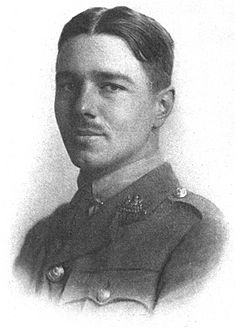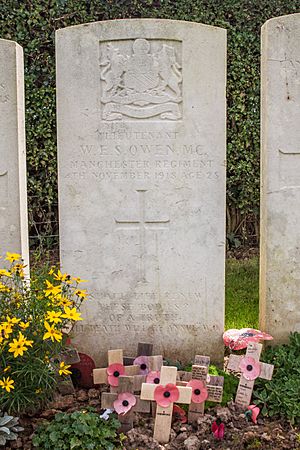Wilfred Owen facts for kids
Quick facts for kids
Wilfred Owen
|
|
|---|---|

A plate from his 1920 Poems by Wilfred Owen, depicting him
|
|
| Born | Wilfred Edward Salter Owen 18 March 1893 Oswestry, Shropshire, England |
| Died | 4 November 1918 (aged 25) Sambre–Oise Canal, France |
| Genre | War poetry |
| Military career | |
| Service/ |
British Army |
| Years of service | 1915–1918 |
| Rank | Lieutenant |
| Unit |
|
| Battles/wars | First World War |
| Awards | Military Cross |
Wilfred Edward Salter Owen (born March 18, 1893 – died November 4, 1918) was an English poet and soldier. He is known as one of the most important poets of the First World War. His poems showed the terrible truth of trench and gas warfare. This was very different from how many people at the time saw war. His writing was greatly influenced by his friend and mentor, Siegfried Sassoon. Wilfred Owen died in battle just one week before the war ended. He was only 25 years old. Some of his most famous poems include "Dulce et Decorum est", "Anthem for Doomed Youth", and "Strange Meeting". Most of his works were published after his death.
Contents
Early Life of Wilfred Owen
Wilfred Owen was born on March 18, 1893, in Oswestry, Shropshire, England. He was the oldest of four children. His parents were Thomas and Susan Owen. When he was young, his family moved several times. They lived in Birkenhead and Shrewsbury.
Wilfred went to school at Birkenhead Institute and Shrewsbury Technical School. He discovered his love for poetry around 1904 during a holiday. He was raised in the Church of England and was very religious as a child. He was influenced by the Bible and Romantic poets like Wordsworth and John Keats.
After school, Owen worked as a teacher's assistant. In 1911, he tried to get into the University of London. He passed the exam but did not get a scholarship, which he needed to afford to go.
From 1911 to 1913, he worked as an assistant to a vicar (a church leader) in Dunsden. During this time, he also took classes at University College, Reading. His experiences there made him question some of his religious beliefs.
In 1913, Owen moved to Bordeaux, France. He worked as a private tutor teaching English and French. There, he met a French poet named Laurent Tailhade. When World War I started, Owen did not join the army right away. He thought about joining the French army but eventually returned to England.
Wilfred Owen's War Service
On October 21, 1915, Wilfred Owen joined the Artists Rifles regiment. He trained for seven months in Essex. In June 1916, he became a second lieutenant in the Manchester Regiment.
At first, Owen found his soldiers difficult. But his experiences in the war quickly changed him. He fell into a shell hole and got a concussion. He was also caught in a trench mortar blast. He spent days unconscious near the remains of a fellow officer.
Soon after, Owen was diagnosed with shell shock. This was a term for the mental trauma soldiers experienced from the horrors of war. He was sent to Craiglockhart War Hospital in Edinburgh for treatment. This was a very important time for him. While recovering, he met another famous poet, Siegfried Sassoon. This meeting changed Owen's life and his poetry.
At Craiglockhart, Owen made friends with other artists and writers. He also taught at a local school. In November, he was allowed to leave the hospital. He spent a good winter in Scarborough, North Yorkshire. In March 1918, he was sent to a military depot in Ripon. Here, he wrote or improved many poems, including "Futility" and "Strange Meeting".
Owen returned to active duty in France in July 1918. He could have stayed in England, but he felt it was his duty to go back. He wanted to continue telling the truth about the war, just like Sassoon. Sassoon was against Owen returning to the trenches.
In late August 1918, Owen was back on the front line. On October 1, 1918, he led his units to attack enemy positions near Joncourt. For his bravery and leadership, he was awarded the Military Cross. This award was very important to him. It helped him feel like a true war poet. However, the award was not officially announced until after his death.
Wilfred Owen's Death
Wilfred Owen was killed in action on November 4, 1918. This happened during the crossing of the Sambre–Oise Canal in France. It was exactly one week before the Armistice was signed, which ended the war. He was promoted to Lieutenant the day after he died.
His mother received the telegram telling her of his death on Armistice Day. At that moment, church bells in Shrewsbury were ringing to celebrate the end of the war. Owen is buried at Ors Communal Cemetery in northern France. The words on his gravestone were chosen by his mother. They are a quote from his own poetry: "SHALL LIFE RENEW THESE BODIES? OF A TRUTH ALL DEATH WILL HE ANNUL" W.O.
Wilfred Owen's Poetry
Many people believe Owen is the greatest poet of the First World War. He is famous for writing about the terrible realities of trench and gas warfare. He had been writing poetry since he was ten years old.
The poet William Butler Yeats was an influence on Owen. However, Yeats did not admire Owen's work as much. He even left Owen out of a collection of modern verse.
Early in his life, Owen was influenced by Romantic poets like Keats and Shelley. His close friend, Siegfried Sassoon, later had a huge impact on his writing style. Owen's most famous poems, "Dulce et Decorum est" and "Anthem for Doomed Youth," clearly show Sassoon's influence. Owen used a special rhyming style called pararhyme and often used assonance.
Owen's poetry changed a lot in 1917. His doctor at Craiglockhart encouraged him to write about his war experiences, especially his dreams. Sassoon also helped him see how powerful poetry could be. Sassoon's use of realism and writing "from experience" changed Owen's romantic style. Owen combined Sassoon's gritty realism with his own romantic ideas. This created a powerful and moving style, which he called "the pity of war."
Owen had plans to publish a book of his poems. But he only saw a few of his poems published before he died. These appeared in The Hydra, a magazine he edited at Craiglockhart War Hospital, and "Miners" in The Nation.
Many of Owen's poems were published after his death. These include Poems (1920) and The Collected Poems of Wilfred Owen (1963). The full collection of his works, The Complete Poems and Fragments, was published in 1994.
Owen's mother also influenced his poetry. His letters to her describe the horrors he saw at the front. They also show how his ideas about the war changed. Owen's religious experiences also shaped his poems. For example, "Anthem for Doomed Youth" describes a funeral on the battlefield. "Exposure" shows his questioning of faith during the war.
Friendship with Siegfried Sassoon
Wilfred Owen greatly admired Siegfried Sassoon. He once told his mother he was "not worthy to light [Sassoon's] pipe." Their friendship had a deep effect on Owen. Owen wrote to Sassoon, "You have fixed my life – however short." Sassoon remembered their time together with fondness.
They parted ways in November 1917 when Owen left Craiglockhart. Owen was stationed in Scarborough for several months. There, he met other artists and writers that Sassoon had introduced him to. He also met famous authors like H. G. Wells and Arnold Bennett. During this time, Owen developed the unique poetic voice he is known for today. Many of his early poems were written at the Clarence Garden Hotel in Scarborough. A blue plaque on the hotel marks its connection to Owen.
Sassoon and Owen stayed in touch through letters. After Sassoon was injured in July 1918, they met again in August. They spent a whole afternoon together. This was the last time they saw each other. About three weeks later, Owen wrote to Sassoon to say goodbye as he was returning to France. They continued to write to each other.
After the war ended, Sassoon waited for news from Owen. He was later told of Owen's death. Sassoon was very sad about losing his friend. He wrote about their friendship in his autobiography, Siegfried's Journey. He described Owen's personality clearly and wrote with great kindness about their time together. Sassoon called Owen's death "a chasm in my private existence." He regretted not realizing sooner how important Owen would be to him as a poet and friend.
Remembering Wilfred Owen
There are memorials to Wilfred Owen in several places. These include Gailly, Ors, Oswestry, Birkenhead (Central Library), and Shrewsbury.
On November 11, 1985, Owen was honored in Westminster Abbey's Poet's Corner. A special stone was unveiled for him and 15 other Great War poets. The words on the stone are from Owen's own writing: "My subject is War, and the pity of War. The Poetry is in the pity."
There is also a small museum at the former Craiglockhart War Hospital. This building is now part of Napier University. The museum holds the "War Poets Collection," which includes items related to Owen.
The forester's house in Ors, France, where Owen spent his last night, has been turned into an art installation. It is a permanent memorial to Owen and his poetry. It opened to the public in 2011.
In 1975, Wilfred's sister-in-law, Mrs. Harold Owen, gave all of his manuscripts, photos, and letters to the University of Oxford's English Faculty Library. This collection also includes Owen's personal library. Anyone can visit these items by arranging it with the librarian.
The Harry Ransom Center at the University of Texas at Austin also has a large collection of letters from Owen's family.
Wilfred Owen Association
The Wilfred Owen Association was created in 1989 to remember Wilfred's life and poetry. This group has set up public memorials in Shrewsbury and Oswestry. They organize readings, talks, and performances. They also encourage exhibitions and conferences to help people learn about Owen's poetry.
Peter Owen, Wilfred Owen's nephew, was the President of the Association until he passed away in 2018. The Association also gives out a poetry award every two years. This award honors a poet for their war poems. Past winners include Sir Andrew Motion and Seamus Heaney.
In November 2015, actor Jason Isaacs unveiled a tribute to Owen. This was at the former Craiglockhart War Hospital in Edinburgh, where Owen was treated for shell shock during World War I.
See also
 In Spanish: Wilfred Owen para niños
In Spanish: Wilfred Owen para niños


